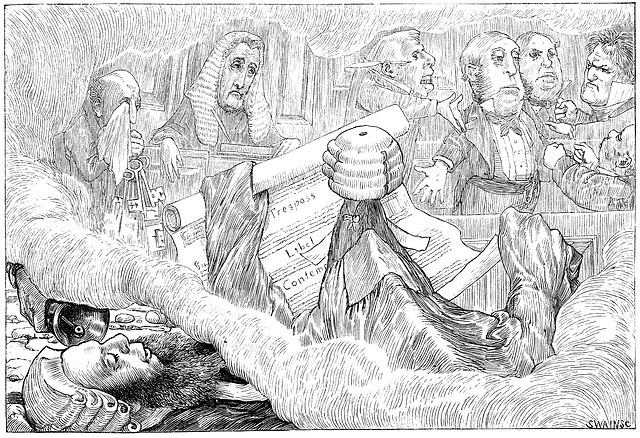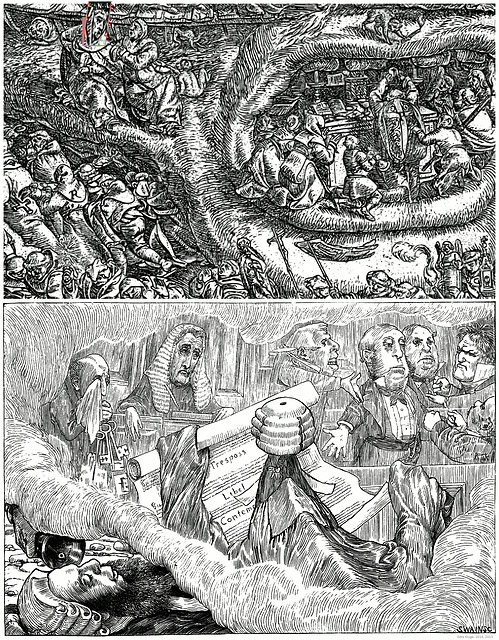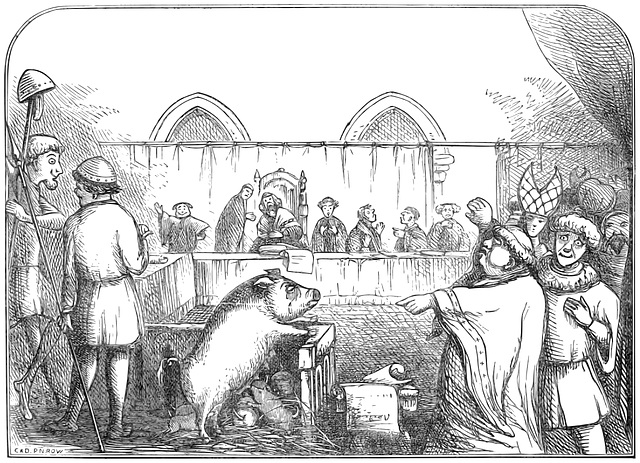
The Barrister
Folder: The Hunting of the Snark
02 Jun 2013
1 comment
The Broker's and the Monk's Nose
[left]: Segment from an illustration by Henry Holiday to Lewis Carroll's The Hunting of the Snark depicting the Broker (upper left corner). The object he is holding at his lips is the handle of a malacca walking cane, a gesture associated with dandies in the Victorian era.
[right]: Segment from anonymous: Edward VI and the Pope , a Tudor anti-papal allegory of reformation (16th century).
Holidays Snark illustrations are conundrums. And the were constructed as conundrums. The pattern in the frame (2) on the left side is an allusion to a rather unobstrusive pattern on the right side. This shows that Holiday did not "copy" patterns just because of they would contribute to the impressiveness of his illustrations.
·
In 1922 (46 years after The Hunting of the Snark was published), Henry Holiday (the illustrator) wrote to George Sutcliffe (Sangorski & Sutcliffe, bookbinders, London): "... you will notice that the Broker in [the proof of the illustration to The Crew on Board ] no. 5 is quite different to the one in [ the later proof ] no. 2. I had intended to give a caricature a the vulgar specimen of the profession, but Lewis Carroll took exception to this and asked me to treat the head in a less aggressive manner, and no. 2 is the result. I consider that no. 5 has much more character, but I understood L. Carroll's objection and agreed to tone him down. ..."
Charles Mitchel called the first design of the broker's face in the lower right corner of the print "conspiciously antisemitic". The change of the printing blocks must have been very important to Carroll, as it took the wood cutter Swain quite some effort to implement that change (see p. 102, Lewis Carroll's The Hunting of the Snark , 1981 William Kaufmann edition).
As shown in the image above, the broker's face also appears in the upper left section of Holiday's illustration to The Hunting . Rather than by a "Semitic" face, Holiday may have been inspired by what could be a cliché of the face of a roman catholic monk depicted in the 16th century anti-papal painting Edward VI and the Pope .
03 Apr 2010
1 favorite
3 comments
William III, Religion and Liberty, Care and Hope
The color markers in both images show, to which pictorial elements in a 1674 print Henry Holiday alluded in his illustration to Lewis Carroll's The Hunting of the Snark (lower image, 1876) in the chapter The Hunting . The print (upper image by an anonymous artist, redrawn by me) is the orartie van de Professor L. Wolsogen over syndroom en de nytlegging van de felue gadaen ... . The animals in that print are based on illustrations by M. Gheeraerts the Elder to Aesop's Fables. (The print now is located at British Museum, BM Satires 1047, reg.no.: 1868,0808.3286 . A scan of the original print showing more details can be obtained from the museum.)
Holiday alluded to that 1674 image depicting William III as well as the allegorical figures for "religion" and "liberty". He discussed with Dodgson (Carroll) about the possible allegorical depiction of "care and hope". Interestingly, the two female members of the hunting crew also are quite similar to the allegories of "religion" and "liberty" shown in the 1674 print, the conflict between both probably being also conflict for the reverend Dodgson.
I made this image in the year 2010. The little inset with the yellow frame was my first presentation (2009-07-09) of the comparison.
23 Jan 2011
2 favorites
2 comments
h40
"What can science reveal of the nature of man and the universe of which it is a part? This is the quest of the Snark."
(Philo M. Buck: "Science, Literatur, and the Hunting of the Snark ", College English, Vol. 4, No. 1, Oct., 1942 )
I too think, that Carroll's poem is about science. It also is about the challenges of scientific research, to beliefs. This depiction of the Snark hunting party conducting a land expedition is one of Henry Holiday's illustrations to Lewis Carroll's The Hunting of the Snark (1876).
26 Jun 2011
3 comments
h60
From Henry Holiday's illustrations to Lewis Carroll's The Hunting of the Snark (1876)
Very large version: www.ipernity.com/doc/goetzkluge/37780784
23 Jun 2013
5 comments
The Snark in your Dreams
The lower image is the only Snark illustration by Henry Holiday which shows the Snark . However, in this case the beast appeared in The Barrister's dream . Therefore it is just a Dream Snark .
[top]: Detail from the etching (1566-1568) The Image Breakers by Marcus Gheeraerts the Elder.
[bottom]: Detail from the illustration (1876) by Henry Holiday to The Hunting of the Snark . Lewis Carroll (C. L. Dodgson) did not want Henry Holiday to depict the Snark in the illustrations to The Hunting of the Snark . But Holiday was allowed to let it appear veiled by its "gown, bands, and wig" in The Barrister's Dream .
Also in this case, Holiday pictorially alluded to the etching by Marcus Gheeraerts the Elder. In this comparison several shapes - see notes (1) to (5) - provide the beholder of the illustration with pictorial quotes which point to that etching.
This is just the place to repeat a textual quote which I like a lot:
"We have neglected the gift of comprehending things through our senses. Concept is divorced from percept, and thought moves among abstractions. Our eyes have been reduced to instruments with which to identify and to measure; hence we suffer a paucity of ideas that can be expressed in images and in an incapacity to discover meaning in what we see. Naturally we feel lost in the presence of objects that make sense only to undeluted vision, and we seek refuge in the more familiar medium of words. ... The inborn capacity to understand through the eyes has been put to sleep and must be reawakened."
(Rudolf Arnheim: Art and Visual Perception, 1974, p. 1)
Images like this could be used in class by arts teachers to reawaken that inborn capacity. This also is a training to make and discuss decisions based on incomplete information.
Am I wrong? Am I right?
"Only those questions that are in principle undecidable, we can decide."
(Heinz von Foerster: Ethics and Second-Order Cybernetics, 1990-10-04, Système et thérapie familiale, Paris)
·
2014-05-19
18 May 2014
3 comments
Carroll's Barrister's Dream
Redrawn image from a concept draft by C.L. Dodgson (aka Lewis Carroll). The original drawing was part of a lot consisting of an 1876 edition of the "Hunting of the Snark" and a letter (dated 1876-01-04) by Dodgson to Henry Holiday. The lot was auctioned by Doyle New York (Rare Books, Autographs & Photographs - Sale 13BP04 - Lot 553) offered in November 2013. The whole lot was sold for US$ 25000.
www.doylenewyork.com/asp/fullcatalogue.asp?salelot=13BP04+++553+&refno=++953647&image=2
Henry Holiday's depiction of a scene from the chapter "The Barrister's dream".
19 May 2014
1 favorite
4 comments
Dream Snarks
[top]: Detail from the etching (1566-1568) The Image Breakers by Marcus Gheeraerts the Elder.
[center]: Detail from the illustration (1876) by Henry Holiday to The Hunting of the Snark . C. L. Dodgson did not want Henry Holiday to depict the Snark in the illustrations to The Hunting of the Snark . But Holiday was allowed to let it appear veiled by its "gown, bands, and wig" in The Barrister's Dream .
[bottom]: Redrawn image from a concept draft by C. L. Dodgson (aka Lewis Carroll). The original drawing was part of a lot consisting of an 1876 edition of The Hunting of the Snark and a letter (dated 1876-01-04) by Dodgson to Henry Holiday. The lot was auctioned by Doyle New York (Rare Books, Autographs & Photographs - Sale 13BP04 - Lot 553) offered in November 2013. The whole lot was sold for US$ 25000. ( www.doylenewyork.com/asp/fullcatalogue.asp?salelot=13BP04+++553+&refno=++953647&image=2 )
·
This shows: First C. L. Dodgson defined the concept [bottom], then Henry Holiday did the artwork (including the allusions to Gheeraert's "head" [top]) and finally Joseph Swain cut the illustration [center] into a woodblock.
01 Mar 2015
1 comment
Trial of a sow and pigs at Lavegny (1457)
Trial of a sow and pigs at Lavegny
Source: openlibrary.org/works/OL3799645W/The_book_of_days
The book of days: a miscellany of popular antiquities in connection with the calendar, including anecdote, biography, & history, curiosities of literature and oddities of human life and character. 14 editions
By Robert Chambers
Page 128
en.wikipedia.org/wiki/Chambers_Book_of_Days (1864)
See also: en.wikipedia.org/wiki/Animal_trial
Illustration from Chambers Book of Days depicting a sow and her piglets being tried for the murder of a child. The trial allegedly in Levagny took place in 1457, the mother being found guilty and the piglets acquitted.
See also: www.academia.edu/10005942/The_Snark_in_your_Dreams
Jump to top
RSS feed- Latest items - Subscribe to the latest items added to this album
- ipernity © 2007-2024
- Help & Contact
|
Club news
|
About ipernity
|
History |
ipernity Club & Prices |
Guide of good conduct
Donate | Group guidelines | Privacy policy | Terms of use | Statutes | In memoria -
Facebook
Twitter









